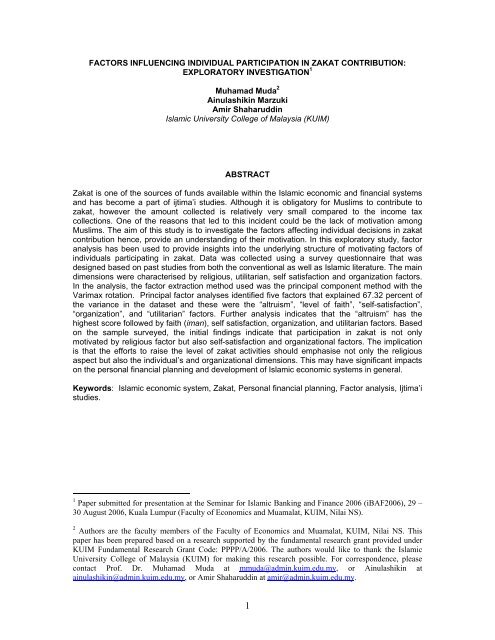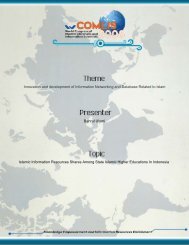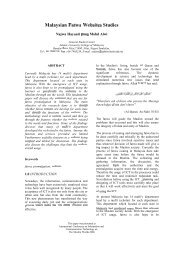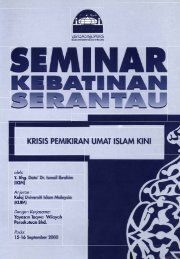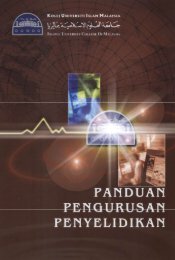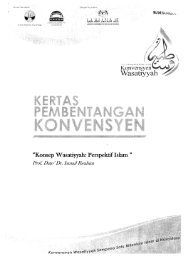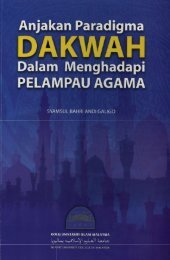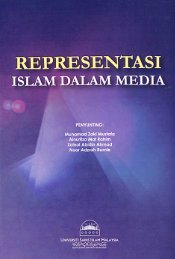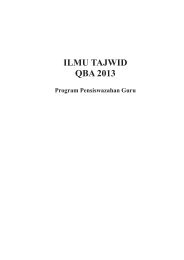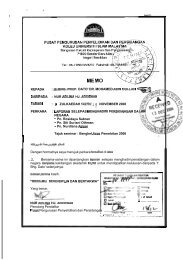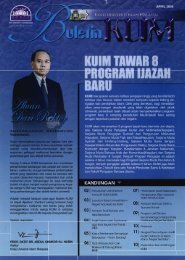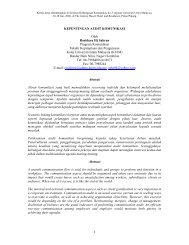Factors Influencing Individual Participation In Za...
Factors Influencing Individual Participation In Za...
Factors Influencing Individual Participation In Za...
Create successful ePaper yourself
Turn your PDF publications into a flip-book with our unique Google optimized e-Paper software.
FACTORS INFLUENCING INDIVIDUAL PARTICIPATION IN ZAKAT CONTRIBUTION:EXPLORATORY INVESTIGATION 1Muhamad Muda 2Ainulashikin MarzukiAmir ShaharuddinIslamic University College of Malaysia (KUIM)ABSTRACT<strong>Za</strong>kat is one of the sources of funds available within the Islamic economic and financial systemsand has become a part of ijtima’i studies. Although it is obligatory for Muslims to contribute tozakat, however the amount collected is relatively very small compared to the income taxcollections. One of the reasons that led to this incident could be the lack of motivation amongMuslims. The aim of this study is to investigate the factors affecting individual decisions in zakatcontribution hence, provide an understanding of their motivation. <strong>In</strong> this exploratory study, factoranalysis has been used to provide insights into the underlying structure of motivating factors ofindividuals participating in zakat. Data was collected using a survey questionnaire that wasdesigned based on past studies from both the conventional as well as Islamic literature. The maindimensions were characterised by religious, utilitarian, self satisfaction and organization factors.<strong>In</strong> the analysis, the factor extraction method used was the principal component method with theVarimax rotation. Principal factor analyses identified five factors that explained 67.32 percent ofthe variance in the dataset and these were the “altruism”, “level of faith”, “self-satisfaction”,“organization”, and “utilitarian” factors. Further analysis indicates that the “altruism” has thehighest score followed by faith (iman), self satisfaction, organization, and utilitarian factors. Basedon the sample surveyed, the initial findings indicate that participation in zakat is not onlymotivated by religious factor but also self-satisfaction and organizational factors. The implicationis that the efforts to raise the level of zakat activities should emphasise not only the religiousaspect but also the individual’s and organizational dimensions. This may have significant impactson the personal financial planning and development of Islamic economic systems in general.Keywords: Islamic economic system, <strong>Za</strong>kat, Personal financial planning, Factor analysis, Ijtima’istudies.1 Paper submitted for presentation at the Seminar for Islamic Banking and Finance 2006 (iBAF2006), 29 –30 August 2006, Kuala Lumpur (Faculty of Economics and Muamalat, KUIM, Nilai NS).2 Authors are the faculty members of the Faculty of Economics and Muamalat, KUIM, Nilai NS. Thispaper has been prepared based on a research supported by the fundamental research grant provided underKUIM Fundamental Research Grant Code: PPPP/A/2006. The authors would like to thank the IslamicUniversity College of Malaysia (KUIM) for making this research possible. For correspondence, pleasecontact Prof. Dr. Muhamad Muda at mmuda@admin.kuim.edu.my, or Ainulashikin atainulashikin@admin.kuim.edu.my, or Amir Shaharuddin at amir@admin,kuim.edu.my.1
INTRODUCTIONTotal zakat collected in 2004 by all Pusat Pungutan <strong>Za</strong>kat (PPZ) in Malaysia was only RM473million (see http://www.zakat.com/prestasi/statistik.html) compared to RM48.6 billion of incometax collected by the <strong>In</strong>land Revenue Board (IRB) (Utusan Malaysia, May 5, 2005) in the sameyear. IRB further estimated that it could collect about RM52.5 billion in 2005. If it is estimatedthat half of the population is Muslim, total zakat collected in 2004 should be at least RM20 billion.This figure indicates that Muslims are contributing to income tax rather than zakat. Realizing thatzakat is the foundation of the financial structure in an Islamic economy, the figure of collection ofzakat is not encouraging. The figure also demonstrates a lack of motivation amongst Muslims topay zakat.Al Quran and Al Hadith dictate that zakat is one of the pillars of Islam and people are obliged topay zakat. While zakat is compulsory, Islam also encourages people to participate in other kindof voluntary charity activities. These voluntary charities include sadaqa, waqaf and hibah.Existing theoretical studies on zakat focus mainly on the fiqhi (juristic) aspects. Among thepopular aspects are collection and distribution of zakat by the state, the imposition of zakat onnew wealth and the levying of zakat on income. However there is lack of empirical research doneon the real experience of people who are paying zakat. Thus this research aims to understandthe influential factors in motivating Muslims to pay zakat. Is it mainly due to religious duty or thereis other factors as well that play significant role in influencing Muslims contributing to zakat? Thefindings of this survey are expected to assist the relevant zakat organizations in increasing theirzakat collection.LITERATURE REVIEWIt has been emphasised that, in Islam, the primary motivation of paying zakat should be theworship factor (ta’abudi). Muslim fulfils their duty in preserving common good by paying zakat,giving the needy and so forth simply because he or she is the servant of Allah s.w.t. <strong>In</strong> fact, theword zakat is repeated 32 times in the Qur’an, showing its importance and obligation (see, forexample, Qur’an 2:43, 83, 110, 277). Muslims obey the religious obligation of zakat because it isone of the five pillars of Islam. <strong>Za</strong>kat is an important instrument for social justice as it leads toincreased prosperity in this world and also leads to increase of religious merit (thawab) in thehereafter as its payment purifies individuals from sins (Muhammad Abdul Aziz, 1987). Al-Quranstates that, “Take from their property alms (sadaqa) in order to purify them that is from sins”(Quran 9:103). Thus obtaining purification is another motivation for paying zakat.Reinstein (2006) also supported worship factor as one of the main motivations that contributes tothe compliance of zakat, sadaqa (donation) and other prosocial behaviour (ijtima’i). They furtherclaimed that the act of paying zakat could be an indicator of high level of iman (faith). This isbecause individual compliance towards religious obligation to pay zakat is highly dependent onhis belief of the religious teaching.Apart from the worship factor, the individuals’ level of understanding in Islamic principles will alsomotivates people to comply the injunction to pay zakat. This is supported by Aidit (1998) andQardawi (1998) who suggested that non-compliance behaviour towards obligation to pay zakat ismainly due to the level of iman in individuals towards religious obligation. Reinstein (2006) alsoidentified that religious belief as an important determinant of religious and secular giving. Lunnet. Al (2001) also agree that one’s religious belief has the impact on one’s giving. Chavez ascited in Lunn et. al. (2001) notes that “the relationship between religious giving and involvement inreligious giving is unambiguously positive”. It is also worth mentioning that Lunn et. al. (2001)concluded that those who attend church regularly and the conservative Presbyterian (comparedto liberal Presybterian) give more.<strong>In</strong> addition to the worship factor (ta’abudi), the studies examining the individual participation inijtimai’ contribution could be investigated through various perspective namely exchange theory,2
social exchange theory and organization. Exchange theory, which was first developed byeconomists, assumes that all transactions involve some kind of exchange and things areexchanged for their economic or utilitarian value. This value could be actual material return ortangible benefits that accrue to the individuals or symbolic value such as pleasure or satisfactionthat an individual derives from the act of giving. Based on economic theory, social exchangetheory was developed. This theory assumes that exchange takes place on the basis of thesymbolic value attached to things (Ekeh, 1974).Both economic and social views assume that individuals engage in exchange to achieve certainimportant goals that are extrinsic to the behaviour they engage in. Extrinsic or instrumentalrewards are a motivation source when individuals believe that behaviour will lead to certainvalued outcomes, utilitarian or symbolic. Within social exchange theory (e.g. Bagozzi 1975,1978, 1979) exchange is anchored in self-interest and individuals attempt to minimize their coststo obtain the most profitable outcomes. However, limits exist with regard to profit, beyond whichindividuals do not pursue self-gain. When these western theories are applied to zakat activities, itis assumed that individuals contribute to zakat because he or she gets some tangible benefits,rewards or self satisfaction from the activity.A number of studies have indicated that the organization factor also plays significant role inmotivating Muslim in paying zakat (Sanep Ahmad et. al, 2005). The collection of zakat inMalaysia was previously governed directly under the religious state affairs department. <strong>In</strong> order toreduce the bureaucracy problems, certain states such as Kuala Lumpur, Selangor, Melaka andPahang have outsourced this task to centres for <strong>Za</strong>kat Collection (PPZ). These centres are anindependent department of the respective state religious department that operates based on thecommercial and professional basis. <strong>In</strong>terestingly, under the management of PPZs, the collectionof zakat in the four states mentioned has increased tremendously. For example, collection ofzakat in Selangor posted an increase of 19.4 percent in 2004 from RM86.3 million to RM107million. (Mohamed <strong>Za</strong>mery, 2005). Based on this figure, Mohamed <strong>Za</strong>mery (2005) believes thatthe privatization of PPZ has significantly influence Muslims in paying zakat in Malaysia. However,the empirical study conducted by Nor Ghani et. Al (2001) does not support the theory. It wasfound that privatization has no significant impact on zakat collection. Other organizational factorssuch as zakat promotional campaign, perceived zakat service quality and salary deductionmechanism were found to influence significantly Muslims in paying zakat (Hairunnizam et. al,2005 and Kamil, 2005).Practices in other muslim countries has found to be slightly different. For example, Muslims in theGulf countries prefer to pay zakat to the charitable organizations and also to the recipients ofzakat (asnaf) directly. This behaviour could due to the misleading effect of religious belief thatzakat is a relation between Muslims and God, thereby it is regarded as an individual efforts ratherthan an organized one. Hence, there appear to be some degree of objections among Muslims inthe Gulf countries to pay zakat to an organization particularly the government religious body(Guermat et. al., 2003).<strong>In</strong> summary, the theories relating to the ijtima’i activities, particularly zakat, could be derived fromvarious perspectives namely exchange theory, social exchange theory, organisation theory andreligious teaching. These will provide a theoretical foundation for understanding what influencepeople to participate in ijtimai (prosocial) activities such as zakat, sadaqa and waqaf. This study,however, focuses mainly on zakat in order to provide an initial insight into the behaviour of ijtima’iparticipants.3
OBJECTIVES, RESEARCH QUESTONS AND METHODOLOGYObjectives and Research QuestionsThe objective of this study is to identify the possible factors that influence individual participationin zakat contribution and to assess the role of formal institutions in motivating Muslimsparticipation in zakat contribution. The research questions formulated to guide this study are asfollows:1) What factors that influence individual participation in zakat contribution?2) Which factors influence most? Are they motivated by religious factor alone since it isobligatory? Or, are there other “worldly” factors that motivate them?Research MethodologyBased on past studies from both the conventional as well as Islamic literature, a questionnairewas constructed for use in the study. The questionnaire is divided into three sections whichinclude a section for screening the respondents, i.e. whether respondents participate in zakat.The next section asked for demographic variables that include gender, age, employment sector,highest academic qualification and monthly income. And finally, the last section that contained 34items asked what motivates individuals to pay zakat. These 34 items were based on fourdimensions which are religious factor (ta’abudi), self-satisfaction, utilitarian factors such asrewards or benefits gained, and organizational factors. The respondents were asked to indicatedtheir agreement pertaining to the statement along the Likert of “1” to “5”, whereby “1” indicates“strongly disagree” and “5” a “strongly agree”.To identify a concise list of explanatory constructs from the responses collected, a factor analysiswas used. Factor analysis is a statistical technique for achieving parsimony by identifying thesmallest number of descriptive terms to explain the maximum amount of common variance in acorrelation matrix (Hair, Anderson and Tatham, 1990; Tinsley and Tinsley, 1987). The factorsdeveloped embody the meaning of the 34 original items within a more concise and useable list.Principal-components analysis (PCA) was used to extract the initial factors identified in thestatistical treatment of the data. Orthogonal rotation using a Varimax procedure was thenperformed on the responses used to minimize the number of loadings on a factor, thus simplifyingthe structure and making the solution more interpretable. Potential factor solutions wereexamined and solutions with factors having an Eigenvalue of less than one were eliminated.Additional inspection of factor solutions also considered the number of items loading on eachfactor, with preference to solutions with more than one item loading on a factor. Carefulconsideration was given to each factor solution that met all of these criteria and the final solutionwas selected to provide the most parsimonious representation of the data collected (Hair et. al,1990 and Tinsley & Tinsley, 1987).FINDINGS, ANALYSIS AND DISCUSSIONDemographic DataDemographic information obtained from the respondents included gender, age, employmentsector, highest academic qualification and monthly income. This information was deemednecessary for this study in order to determine how demographic classifications affected themotivation to participate in zakat contribution.Sixty questionnaires were drop-off to respondents. Only 53 respondents return usablequestionnaires. Out of 53 respondents, 49 percent are male while 51 percent is female. Majorityof the respondents (69.8 percent) works in government sector. Only 17 percent of therespondents hold STPM qualifications and below, while 67.9 percent at least have first degree4
qualification. Almost half of the respondents (47.2 percent) earn income between RM1,500 andRM3,000 per month. Table 1 provides the complete details for the respondents’ profile.Table 1Frequency Counts for Respondents by Gender, Age, Employment Sector, Academic Qualificationand Monthly <strong>In</strong>comeGrouping Variables Frequency PercentGender (n=53)Male 26 49Female 27 51Age (n=53)18 - 24 1 1.925 - 34 32 60.435 - 44 10 18.945 - 54 6 11.3Above 55 4 7.5Employment Sector (n=53)Government 37 69.8<strong>In</strong>dustrial/manufacturing 2 3.8Services 3 5.7Self-employed 3 5.7Others 8 15.1Academic Qualification (n=53)Profesional 1 1.9Master /Ph.D 23 43.4First Degree 12 22.6Diploma/STPM/STAM 8 15.1SPM/Certificate/7 13.2Matriculation cert.Others 2 3.8Monthly <strong>In</strong>come (n=53)< RM1,500 6 11.3RM1,501 - RM3,000 25 47.2RM3,001 - RM4,500 18 34.0RM 4,501 - RM6,000 3 5.7> RM6,001 1 1.9<strong>Factors</strong> <strong><strong>In</strong>fluencing</strong> <strong><strong>In</strong>dividual</strong> <strong>Participation</strong> <strong>In</strong> <strong>Za</strong>kat ContributionWhen carrying through a rotated factor analysis, five factors with eigenvalues above one werefound which explain 67.32 percent of the total variance. By looking at the scree plot (Figure 1),the most important factors are the first three because that is where the bend occurs. Followingthe eigenvalues above one, the five factors collectively explained all of the 34 items on thequestionnaire. For each factor a label which captured the essence of the loading items wasidentified. The constructs identified were level of iman (faith), altruism, self-satisfaction, rewardand organization. <strong>In</strong> interpreting the items that loaded on each factor, the 0.50 level is a generallyaccepted minimum factor loading. Decisions about labels to attach to factors generated by thestatistical process were made after considerable examination and discussion about the itemsincluded under each factor.5
12Scree Plot10864Eigenvalue2013579111315171921232527293133Component NumberFigure 1: Scree PlotFactor 1: Organizational FactorThe first factor that influences individual participation in zakat contribution is comprised of itemsrelated to organizational factor. This includes the availability of zakat collection center and thevarious services provided to facilitate zakat activity which accounted for 28.85 percent ofvariance. Table 2 provides a list of organizational factor item, factor loadings, item means andstandard deviation. A respondent that scores high on this factor is one who believes that zakatcollection center places a strong influence in Muslims zakat contribution. Based on the itemmean, confidence in zakat collection center has the highest mean score which indicates that theorganization that involves in zakat collection and distribution needs to be efficient, effective andtransparent in its administration in order to instill high public confidence so that the amount ofzakat collected would be increased.Table 2Item, Variable Loadings, Item Mean and Standard Deviation for Factor 1: Organizational FactorItem Loading Item Mean StandardDeviationAvailability of payment facility 0.811 2.60 1.23Availability of collection center 0.886 2.60 1.21Convenient payment system 0.902 2.45 1.22Confidence in zakat collection center 0.831 2.91 1.27Salary deduction facility 0.659 2.42 115Services offered by zakat collection center 0.921 2.53 1.14Satisfactory service 0.873 2.40 1.18<strong>In</strong>formation on collection and distribution is 0.574 2.72 1.20transparentProfessionally managed 0.749 2.79 1.17<strong>In</strong>fluenced by zakat advertisement 0.875 2.43 1.10On line payment facility 0.887 2.47 1.156
Factor 2: AltruismThe items that are loaded on this factor are descriptive of altruistically motivated. This factoraccounted for 19.51 percent of the variance. This factor relates to how religious beliefs or moralvalues influence individual to participate in zakat. Altruism according to Batson (2002) is themotivation with the ultimate goal of increasing the welfare of one or more individuals other thanoneself. Altruism also refers to “intuitive” moral values and norms (Kolm, 2005). Table 3provides all the items that are loaded to this factor. The highest mean score is to show gratitudeand to get blessing from Allah.Table 3Variable Loadings and Item Means for Factor 2: AltruismItem Loading Item Mean StandardDeviationRights of poor and needy 0.783 4.53 0.80To show gratitude 0.841 4.72 0.56To get blessing from Allah 0.828 4.70 0.57<strong>In</strong>crease level of piety 0.851 4.51 0.75Cleanse one’s wealth 0.798 4.62 0.71To help poor and needy 0.875 4.57 0.64Sense of guilt 0.613 3.79 1.08Factor 3: RewardThe third factor is made up of items that related to individual self benefit from the act of payingzakat. Benefit gained includes tangible return and social approval. This self centered motivescomprised of to be seen as generous, to increase business opportunity, to get praised and socialsupport. Based on table 4, the highest mean score is 1.57 where individual is motivated to payzakat to get more business opportunity. This factor accounts for 7.92 percent of the totalvariance.Table 4Variable Loadings and Item Means for Factor 3: RewardItem Loading Item Mean StandardDeviationTo be seen as generous 0.646 1.42 0.53<strong>In</strong>crease business opportunity 0.773 1.57 0.80To get praised 0.870 1.28 0.45To get social support 0.844 1.34 0.59Factor 4: Self-SatisfactionThe items that are loaded on this factor are identified as self satisfaction. They are individuallysatisfied from the act of giving zakat. They feel happy paying zakat, they are responsible society,generous and believe that they could also motivate others to participate in zakat contribution.This factor accounts 5.93 percent of the total variance.7
Table 5Variable Loadings and Item Means for Factor 4: Self satisfactionItem Loading Item Mean StandardDeviation<strong>Za</strong>kat improves Muslim economic condition 0.572 4.30 0.87I am a socially responsible person 0.788 3.72 1.10I am happy to pay zakat 0.578 3.87 1.04I am generous 0.642 2.57 1.25I like to be an exemplary 0.638 2.83 1.12Factor 5: Level of Iman (Faith)The last factor is mainly loaded with injunctions from Allah with regards to the obligation of payingzakat, reward for heaven for those who obediently follow the injunction and the punishment in hellthereafter if they do not contribute to zakat. These variable loadings are best identified as level ofiman (faith). This factor accounts 5.11 percent of the total variance.Table 6Variable Loadings and Item Means for Factor 5: Level of iman (faith)Item Loading Item Mean StandardDeviationHeavenly reward 0.745 3.77 1.44Belief in punishment in hell 0.681 4.06 1.28It is obligatory 0.583 4.75 0.43Ranking the <strong>Factors</strong> by Composite Score Analysis<strong>In</strong> order to provide further understanding to the research problem, the factors were rank in termsof its composite score. The composite scores are calculated by dividing the total mean of each ofthe items loaded in a factor by the number of items loaded in its respective factor. The results areshown in table 6. The highest rank (4.5) is altruism followed by the level of iman (faith) (4.19),self-satisfaction (3.46), organization factor (2.57), and utilitarian (1.40).Table 7Ranking of the factors by Composite <strong>In</strong>dexRank <strong>Factors</strong> Total Mean Composite Score1 Altruism 31.47 4.502 Level of iman (faith) 12.58 4.193 Self satisfaction 17.29 3.464 Organization Factor 28.32 2.575 Rewards 5.61 1.408
DISCUSSION AND CONCLUSIONRespondents were asked about their motivation factors on zakat contribution using surveyquestionnaire method. Factor analysis was used to identify factors that are related to themotivation of zakat contribution. The results of the factor analysis show that the items used in thesurvey split into distinct factors, describing religious, self-satisfaction and organization.Altruism is identified as the main factors influence individual to pay zakat followed by religious,self satisfaction and organization factors. Reward has been found not to be the reason for zakatcontribution. Based on this finding it can be concluded that individuals pay zakat not only becauseof religious factor, such as level of iman and belief but also because of satisfaction received fromperforming the activity, not only for one-self but for the happiness of others as well. Thesefindings are consistent with the previous studies, for example Aidit (1998), and the contention inreligious teaching such as Qardawi (1998). However, based on this study, there are other factorsthat contribute to motivate the respondents to participate in zakat. These factors include selfsatisfactionand organization factors.Results of this finding indicate that personal reward is not an important contribution for individualsto involve in an exchange. This may not support the contention of the theory of exchange whichassumes that individual involves social or obligatory activities are motivated by the exchange fortangible benefits or rewards. It is also interesting to note that tax rebate is not the major influencefor Muslims in contributing to zakat as the mean score is only 2.55.Organization factor is also important. Even though the composite score is only 2.57, we cannotignore this factor. This is because there are some respondents maintained that they pay zakatbecause they are satisfied and rely on the services offered by the organization responsible in thecollection of zakat. This is also evidenced by the significant improvement in recent years due toinstitutionalized efforts.ReferencesAidit. 1998. <strong>Za</strong>kat-Satu Tinjauan. Petaling Jaya: IBS Buku Sdn. Bhd.Bagozzi, R. P. 1975. Marketing as Exchange. Journal of Marketing. Vol. 39. No. 4. pp. 32-9.Bagozzi, R. P. 1978. Marketing as Exchange: A Theory of Transactions in the Marketplace.American behavioural Scientist. Vol. 21. No. 4. pp. 535-56.Bagozzi, R. P. 1979. Towards a Formal Theory of Marketing Exchanges. <strong>In</strong> Ferrell, O.C. Brown,S.W., Lamb, C.W. Jr. (Eds). Conceptual and Theoretical Developments in Marketing. AMA,Chicago, IL. pp. 431-47.Ekeh, Peter P. 1974. Social Exchange Theory: The Two Traditions. Cambridge, MA : HarvardUniversity Press.Guermat, C., A. T Al-Utaibi, J.P Tucker. 2003. The Practice of <strong>Za</strong>kat: An Examination of Four GulfCountries, http://www.exeter.ac.uk, 3/8/2006.Hair, J.F, R.E Anderson & R.L. Tatham. 1990. Multivariate Data Analysis. 2 ndPublishing Company.ed. MacmillanHairunnizam Wahid, Sanep Ahmad and Mohd. Ali Mohd Noor. 2005. Kesedaran Membayar <strong>Za</strong>katPendapatan di Malaysia. Seminar Ekonomi dan Kewangan Islam, Fakulti Ekonomi, UniversitiUtara Malaysia, 29-30 August, pp 265-274.9
Kamil Md. Idris. 2004. Kesan Persepsi Undang-undang dan Penguatkuasaan <strong>Za</strong>kat TerhadapGelagat Kepatuhan <strong>Za</strong>kat Pendapatan Gaji. Prosiding Muzakarah Pakar <strong>Za</strong>kat, UniversitiKebangsaan Malaysia, pp. 201-212.Kamil Md. Idris. 2005. The Role of <strong>In</strong>trinsic Motivational <strong>Factors</strong> on Compliance Behaviour of<strong>Za</strong>kat on Employment <strong>In</strong>come, in Isu-isu Kontemporari <strong>Za</strong>kat di Malaysia. 1 st ed., pp. 137-170,Melaka: IKAZ, UiTM.Lunn, J., Klay, R. & Douglass, A. 2001. Relationship among Giving, Church Attendance, andReligious Belief: The Case of the Presbyterian Church (USA). Journal for the Scientific Study ofReligion, 40 (4), 765-775.Muhammad Abdul Aziz. 1987. <strong>Za</strong>kat & Rural Development in Malaysia- An Ethical Analysis of theConcepts of Growth & Redistribution of <strong>In</strong>come. Unpublished Thesis, UM Dissertation Service,Malaysia.Mohamed <strong>Za</strong>mery. (2005). The Role of <strong>Za</strong>kat in Risk Management for the Poor.www.icmf.org/2k4takaful. Retrieved 16 October 2006.Nor Ghani Md Nor, Mariani Majid, Jaafar Ahmad and Nahid Ismail. 2001. Can PrivatisationImprove Performance? Evidence from <strong>Za</strong>kat Collection <strong>In</strong>stitutions. Bengkel Ekonomi Islam.Fakulti Ekonomi, UKM.Qardawi, Yusof. 1998. Peranan Nilai dan Akhlak dalam Ekonomi Islam. (terj). Kuala Lumpur.Metacorp Bhd.Reinstein, D. 2006. Does one contribution come at the expense of another? Empirical evidenceon substitution among charitable donations.Sanep Ahmad, Hairunnizam Wahid & Adnan Mohamad. 2005. Penswastaan <strong>In</strong>stitusi <strong>Za</strong>kat danKesannya Terhadap Pembayaran Secara Formal di Malaysia. dalam Abu Sufian et.al (penyt)Pascasidang Seminar Ekonomi & Kewangan Islam. Kuala Lumpur: Univision Press Sdn Bhd hlm251-264Tinsley, H.E.A., & Tinsley, D.J. 1987. Uses of Factor Analysis in Counseling PsychologyResearch. Journal of Counseling Psychology. pp. 34(4), 414-424.10


